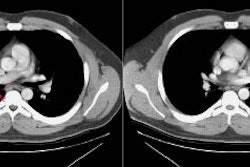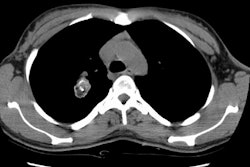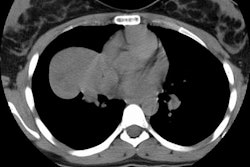International Staging System for Lung Cancer
The International Staging System for Lung Cancer provides a common framework for the discussion of patients with bronchogenic carcinoma. More importantly, however, patient treatment options and prognosis are directly related to their tumor stage at presentation. The staging system is derived from a TNM classification scheme (T=primary tumor, N= regional lymph nodes, M= distant metastasis) with four separate stage groups from I to IV. Stage I reflects the best prognosis, stage IV the worst. Prior to discussion of specific stages, one must understand the TNM descriptors. [214,215]
TNM Descriptions
Primary Tumor (T)
"T" describes the primary tumor in
terms of size (measured in the long-axis diameter) and extent of
invasion. The use of multiplanar reformmated images in the
coronal and sagittal plane has been recommended in order to
obtain the most accurate maximum tumor dimension [1]. There are
four "T" classifications that are commonly applied (T1 through
T4):
T1: Tumor is surrounded by lung or visceral pleura, without bronchoscopic evidence of invasion more proximal than the lobar bronchus (i.e., not in the main bronchus)
T1a: A tumor less than or equal to 1cm in greatest dimension
T1b: A tumor more than 1 cm, but less than or equal to 2 cm in greatest dimension
T1c: A tumor larger than 2 cm and less than or equal to 3 cm in greatest dimension
T2: A tumor larger than 3
cm, but less than or equal to 5 cm surrounded by lung, or with
any of the following features- involvement of a main bronchus
regardless of the distance from the carina, invasion of the
visceral pleura, or associated with partial or complete lung
atelectasis or pneumonitis extending to the hilum. Visceral
pleural invasion has been defined as invasion extending through
the elastic layer of the viseral pleura to the surface of the
viseral pleura- use of elastin stains is recommended for
determination of this feature [195].
T2a: A tumor larger than 3 cm, but less than or equal to 4 cm
T2b: A tumor larger than 4 cm, but less than or equal to 5 cm
T3: A tumor more than 5 cm and less than or equal to 7 cm in size; or of any size that directly invades any of the following: parietal pleura, the chest wall (including superior sulcus tumors and those with rib destruction), parietal pericardium, or phrenic nerve; or a tumor with a satellite tumor nodule in the same primary tumor lobe. A Pancoast tumor involving only the T1 or T2 nerve roots is classified as T3 [215]. For a tumor that is confined to a single lobe but is difficult to measure, the T3 descriptor should be assigned [214].
T4: A tumor larger than 7 cm
or of any size that invades any of the following: mediastinum,
diaphragm, heart, great vessels, trachea, recurrent laryngeal
nerve, esophagus, vertebral body, carina, or recurrent laryngeal
nerve. Also- tumor nodules in a different lobe of
the same lung (but not in the same lobe as the primary tumor). The
T4 descriptor should also be assigned to disease in which there is
extension of tumor into an adjacent lobe or there is a discrete
separate area of tumor involvement of an adjacent lobe [214]. A
Pancoast tumor involving the C8 or higher nerve roots, cords of
the brachial plexus, subclavian vessels, vertenral bodies, or
spinal canal is classified as T4 [215].
Other primary tumor descriptors which are less commonly applied include:
- TX: A primary tumor cannot be assessed, or tumor proven by the presence of malignant cells in sputum or bronchial washings, but not visualized by imaging or bronchoscopy.
- T0: No evidence of a primary tumor
- TIS: Carcinoma in situ
Regional Lymph Node Status (N)
There are four "N" classifications that are commonly applied (N0 through N3). A new nodal chart has also been created that places lymph nodes into 7 specific zones: supraclavicular, upper, aortopulmonary, subcarinal, lower, hilar-interlobar, and peripheral [195]. Although the number of involved nodes seems to affect survival (along with the presence of skip metastases), this was not incorporated into the new staging scheme (5 year survival for a single N1 node was 48%, for multiple N1 nodes was 35%, for a single N2 node was 34%, and for multiple N2 nodes the survival rate was 20%) [192,195,215].
In general, after draining to ipsilateral hilar lymph nodes, tumors in the right upper lobe drain to right paratracheal nodes, those in the left upper lobe drain to the peri- and subaortic lymph nodes, and those from the middle and lower lobes drain to subcarinal nodes [197]. However, direct drainage to mediastinal nodes without draining to hilar and interlobar nodes can sometimes occur (skip metastases)- most frequently occurs with upper lobe tumors and adenocarcinomas [197].
N0: No regional lymph node metastasis
N1: Ipsilateral peribronchial or hilar nodal metastases; or intrapulmonary nodes involved by direct extension of the primary tumor. All N1 nodes lie distal to the mediastinal pleural reflection and within visceral pleura [167].
N2: Ipsilateral mediastinal and subcarinal lymph nodal metastases. Midline pre-vasuclar and retrotracheal nodes are considered ipsilateral [5], while nodes to the contralateral side of midline are considered N3. Although subcarinal nodes may extend into the contralateral mediastinum, they are generally considered to be N2.
N3: Contralateral mediastinal or contralateral hilar nodal metastases; also includes any ipsilateral or contralateral scalene or supraclavicular nodes. Supraclavicular lymph node metastases are found more frequently in patients with N2 or N3 disease [155]. Up to 53% of patients with enlarged N3 nodes will have supraclavicular nodal metastases [155]. Other cervical nodes are classified M1 [5].
NX: Regional lymph nodes
cannot be assessed
It has also been recommended that
for pathologic staging the number of lymph node stations
involved and the presence or absence of skip metastases should
be recorded [214]]. For any nodal station (N1-N3) involvement of
a single lymph node station should be classified "a" and
involvement of multiple stations should be designated "b" [214].
A nodal skip metastasis should be designated "1" and a "2"
indicates there are no skip metastases - for instance pN2a1 or
pN2a2 [214].
Distant Metastasis (M)
M0: No distant metastasis
M1:
M1a: Malignant pleural or pericardial effusion, tumor with pleural nodules, or separate tumor nodule or nodules in the contralateral lung are considered M1a if they are of the same histologic cell type as the primary lesion (5-year survival rate is only 3% [197]). A lung nodule with a different cell type is considered a synchronous primary lesion and should be staged independently.
M1b: Single distant metastasis outside the thorax (involving a single organ).
M1c: Multiple metastases in one or more distant organs
MX: Presence of distant metastasis cannot be assessed
Staging of Bronchogenic Carcinoma
Clinical staging
(pre-operatively) is denoted by the prefix "c" prior to the TNM
designation, while a "p" indicates the surgical-pathologic
staging.
| Stage | Tumor | Nodes | Metastases |
| Stage 0
|
TIS- Carcinoma in situ | ||
| I A1 |
T1a (minimally
invasive) T1a |
N0 N0 |
M0 M0 |
| I A2 |
T1b |
N0 |
M0 |
| I A3 |
T1c |
N0 |
M0 |
| I B |
T2a | N0 | M0 |
| II A |
T2b
|
N0
|
M0 |
| II B | T1a/b/c T2a/T2b T3 |
N1 N1 N0 |
M0 M0 M0 |
| III A | T1 or T2
T3 T4 |
N2
N1 N0 or N1 |
M0
M0 M0 |
| III B | T1 or T2 T3 T4 |
N3 N2 N2 |
M0 M0 M0 |
| III C |
T3 T4 |
N3 N3 |
M0 M0 |
| IV A |
Any T | Any N | M1a/M1b |
| IV B |
Any T |
Any N |
M1c |
The 5 year survival rates for the
new clinical stages were IA 50%, IB 47%, IIA 36%, IIB 26%, IIIA
19%, IIIB 7%, and IV 2% [192]. For pathologic staging the
survival rates were IA 73%, IB 58%, IIA 46%, IIB 36%, IIIA 24%,
IIIB 9%, and IV 13% [192].




